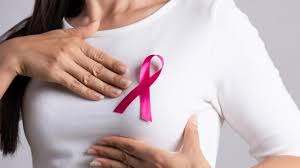Breast cancer is a type of cancer that originates in the cells of the breast tissue, most commonly in the milk-producing glands (lobules) or the ducts that carry milk to the nipple. It can affect both men and women, although it is far more common in women.
Here’s an overview of breast cancer:
- Causes and Risk Factors:
- Genetic Factors: Some individuals have a higher risk due to genetic mutations, such as BRCA1 and BRCA2.
- Gender: Women are at a significantly higher risk than men.
- Age: The risk of breast cancer increases with age.
- Family History: A family history of breast cancer can increase one’s risk.
- Hormones: Hormone replacement therapy and early menstruation/late menopause may elevate risk.
- Radiation Exposure: Prior chest radiation therapy can be a risk factor.
- Types of Breast Cancer:
- Ductal Carcinoma in Situ (DCIS): Abnormal cells are found in the lining of a breast duct but haven’t invaded nearby tissues.
- Invasive Ductal Carcinoma (IDC): Cancer cells have invaded nearby breast tissues outside the duct.
- Invasive Lobular Carcinoma (ILC): Cancer begins in the milk-producing glands and spreads to surrounding tissues.
- Triple-Negative Breast Cancer: This type lacks estrogen, progesterone, and HER2 receptors, making it challenging to treat.
- HER2-Positive Breast Cancer: This type overexpresses a protein called HER2 and is treated with targeted therapies.
- Symptoms:
- A lump or thickening in the breast or underarm.
- Changes in the size, shape, or appearance of the breast.
- Unexplained pain in the breast or nipple.
- Nipple discharge (other than breast milk).
- Skin changes on the breast (redness, dimpling, or scaling).
- Diagnosis:
- Mammography: X-ray of the breast to detect abnormalities.
- Ultrasound: Uses sound waves to create an image of breast tissue.
- Biopsy: Removal of a tissue sample for examination under a microscope to confirm cancer.
- Staging: Doctors use a staging system (usually from 0 to IV) to determine the extent of the cancer, which helps guide treatment decisions.
- Treatment:
- Surgery: Options include lumpectomy (removal of the tumor) or mastectomy (removal of the entire breast).
- Radiation Therapy: Used to kill cancer cells or prevent their growth.
- Chemotherapy: Medications to kill or control cancer cells throughout the body.
- Hormone Therapy: For hormone receptor-positive cancers, drugs may block hormones that fuel cancer growth.
- Targeted Therapy: Medications targeting specific proteins involved in cancer growth (e.g., HER2).
- Prognosis: The outlook for breast cancer varies depending on the stage at diagnosis and the type of cancer. Early detection and treatment generally result in a better prognosis.
- Prevention: Reducing the risk of breast cancer involves maintaining a healthy lifestyle, including regular exercise, a balanced diet, limited alcohol consumption, and avoiding smoking. Regular breast self-exams and mammograms for early detection are also essential.
- It’s crucial for individuals to be aware of their risk factors, perform regular breast self-exams, and undergo recommended screenings to detect breast cancer at an early and treatable stage. If you or someone you know suspects they may have breast cancer or have concerns, it’s important to consult with a healthcare provider for proper evaluation and guidance.



